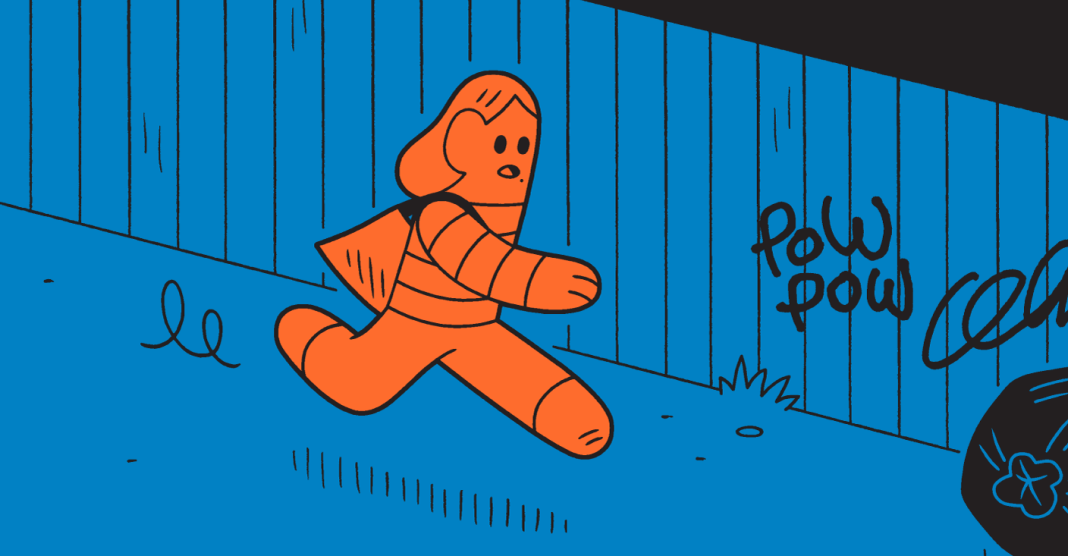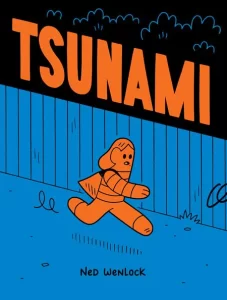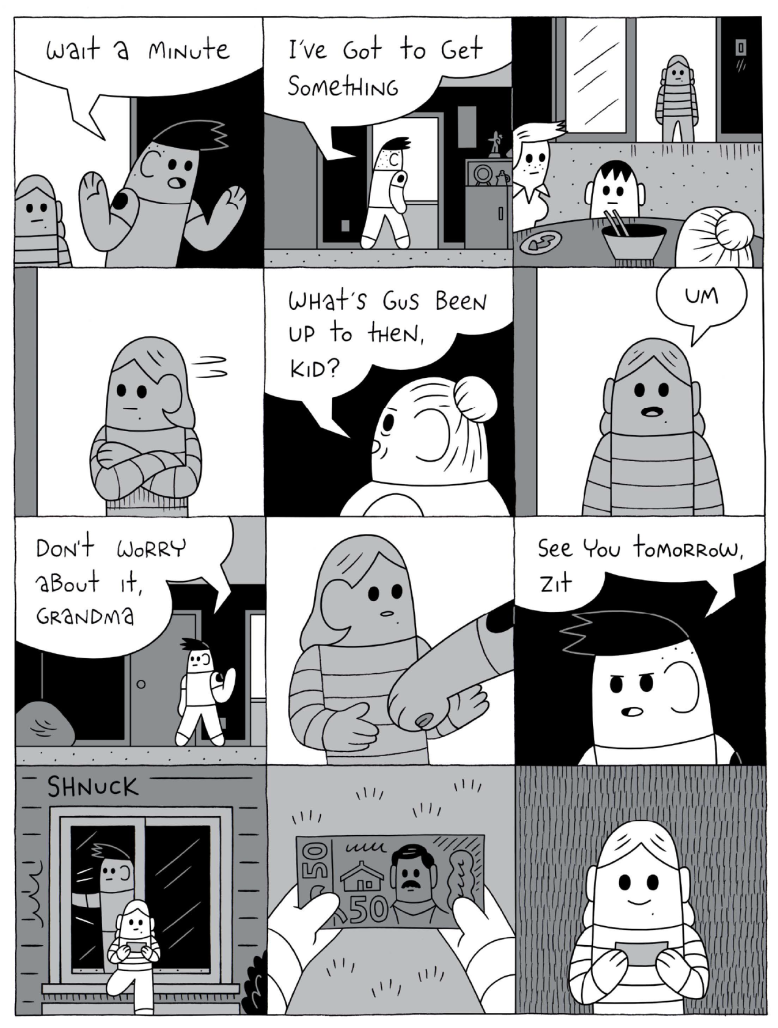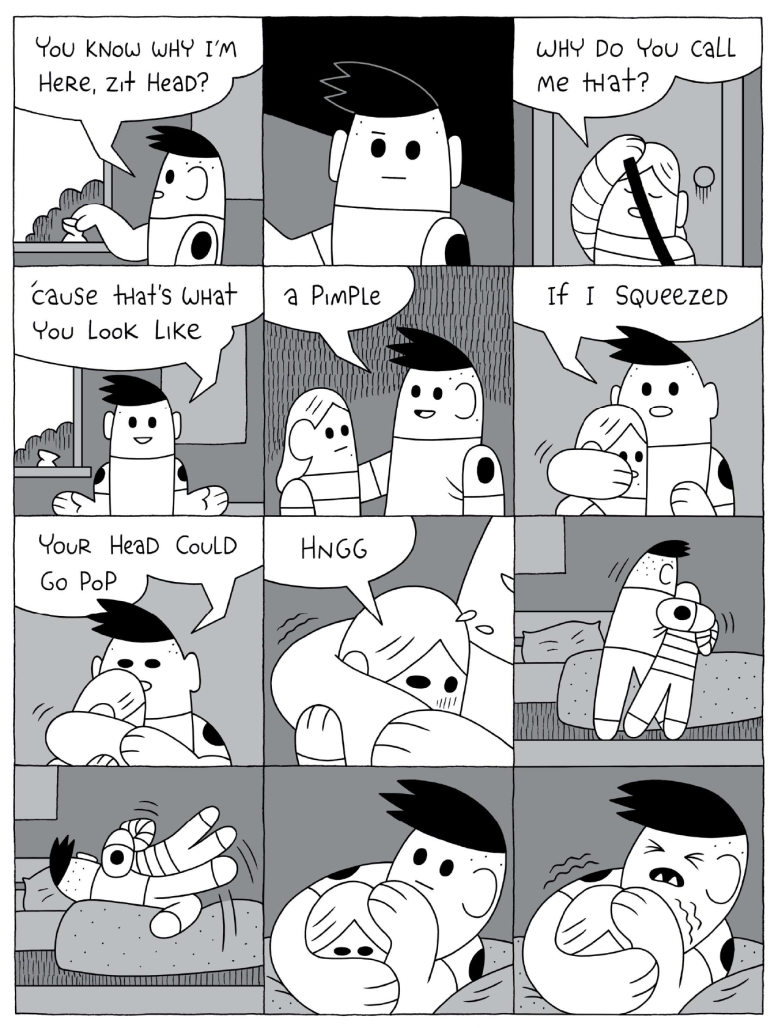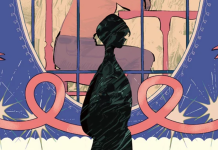Tsunami
Creator: Ned Wenlock
Publisher: Pow Pow Press
Publication Date: May 2025
From the start, Ned Wenlock’s debut graphic novel Tsunami disarms you with its minimal style and simplified, oblong characters. The opening scene takes it slow, with a series of full page images of a mother and grandmother walking along the waterfront as a young boy tramples through the sand in front of them. They discuss his innocence and small size. It is a moment of tranquility as the future spreads out before them, endless as the sea. Water is a continual motif throughout the book. Notably the main character, 12-year-old Peter, cannot swim.
The tranquility is quickly undercut as the scene shifts to Peter’s dysfunctional homelife. Peter sits quietly watching his parents bicker. Wenlock constructs the book with tight square panels, the pages packed with detail. The figures are simple and the backgrounds constructed of blocky shapes but there is meticulous attention given to the setting and the positioning of the characters within it.
Peter is a bullied boy and his parents are on the brink of divorce. He is tormented by his neighbor Gus, a rough kid with an absent, flaky dad, and his pack of friends who are desperate for the attention of girls but do not know how to show affection any way but teasing and cruelty. There is a Sisyphean comedy to the way the boys race across the page, zigzagging through woods and alleyways as the bullies try to catch and pummel Peter.
The pages, with their razor thin gutters between square panels, push you along quickly, but the writer punctuates the flow of conversations with silent reaction panels, like the best comic strip cartoonists, that adds a sense of rhythm and humor. Wenlock has a terrific sense of timing and the silent moments and small shifts in expression or direction of the character adds to the patter of the dialogue. The use of only the most basic lines to represent emotion and action on the abstracted characters, means the way the characters speak is paramount to telling the story. Just as important are the jam-packed layouts and panels that make Peter’s world claustrophobic and stifling.
But then, Wenlock takes a moment, a full page, a quarter, a large corner, to revel in the sense of place. It is in these spaces where the squares allow the reader to catch their breath that we truly enter into Peter’s world and the quiet contemplation as this sensitive kid tries to make sense of a noisy world. Without words we understand that his relationship to his parents, each of whom are dishonest with one another and with him about the state of their marriage, impacts his relationship to the other teens surrounding him. He cannot stand dishonesty and lying and is unable to stop himself from being blunt in his disgust with his bullies. That only makes things worse for him until a new girl, Charlie, comes to school and finds his strange integrity charming.
Like Peter and like Gus, Charlie is a young person plagued by doubts and anxieties and fears. None of the characters’ emotions are spelled out explicitly but they are told through glimpses into their lives and families. Each is isolated in their own way and every time it feels like they might bridge the gap, there is a new wave crashing upon the shoreline to divide them. The river, its rushing tide and rapid current, pulls each in time and again, further from one another. “Friendship is mysterious,” Charlie’s dad tells her as she opines over missing her friends from their last home and her anxiety over making new ones, “You simply spend time with someone, share some experiences, then whammo, before you know it you are friends!” It sounds so simple but at this vulnerable age, to let someone intrude on your time is to be too vulnerable.
The goofy looking characters and the offbeat square grids in Tsunami lull you into a sense of comfort early on, with a fairly lighthearted approach to childhood and its many travails that recalls A Christmas Story more than Catcher in the Rye. But as the story goes on, the bravado and hard-headedness of youth reveal the dangers of childhood cruelties. The mundane trials, the absence of healthy models for how to grow and mature, leave these children at the mercy of the river’s current. What starts out as a cute, funny little book becomes something far more complex and emotional that belies its simple-seeming artwork. The wide open, full-page images of the tranquil seaside that open the book are mirrored in its final moments, not as a symbol of boundless possibility but as a reminder of the world’s dangers and indifference. To say much more is to take away the impact of the story’s quiet, complex, and tender narrative.
Tsunami is a stirring debut, a disarming feat of cartooning that taps into the highs and lows of growing up and the quiet internal battles that can sweep away the vulnerable.
Tsunami is now available from Pow Pow Press!
Read more great reviews from The Beat!

